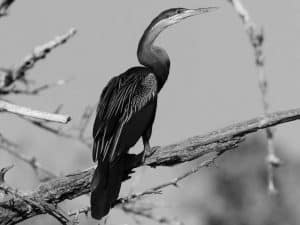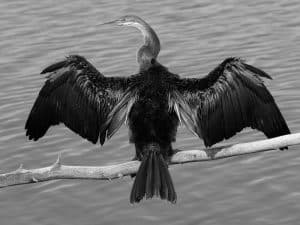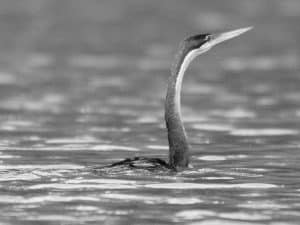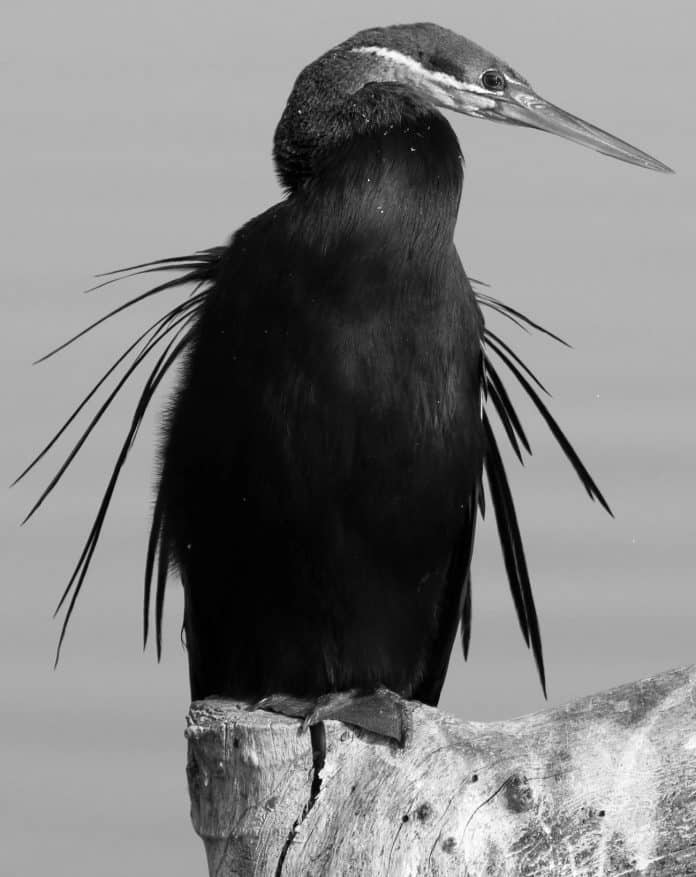Introduction to the African Darter
The African Darter, scientifically known as Anhinga rufa, is a striking bird species that can be found in the waterways of Tanzania. This unique avian marvel is known for its distinct appearance and remarkable hunting techniques. With its long, slender neck, sharp beak, and sleek, dark plumage, the African Darter in Tanzania is a captivating sight for wildlife enthusiasts and birdwatchers alike. As an expert swimmer and adept fisher, the African Darter has carved out a niche in the aquatic ecosystems of Tanzania, making it a fascinating subject of study and observation.
The African Darter’s name is derived from its impressive diving abilities, resembling that of a dart, as it swiftly and stealthily plunges into the water to catch its prey. This behavior sets it apart from other waterfowl and contributes to its unique charm. The species is also known for its distinctive elongated body, which allows it to move effortlessly through the water, making it a truly remarkable sight to behold. As we delve deeper into the habitat, behavior, and ecological significance of the African Darter, we will uncover the beauty and importance of this aquatic marvel in Tanzania’s waterways.
Habitat and Distribution of the African Darter in Tanzania
Tanzania’s diverse and rich ecosystem provides an ideal habitat for the African Darter, with its extensive network of water bodies including lakes, rivers, and wetlands. These diverse waterways offer a varied and abundant supply of fish and other aquatic prey, making them an attractive environment for the African Darter to thrive. From the shores of Lake Victoria to the vast wetlands of the Selous Game Reserve, the African Darter can be found across various regions of Tanzania, adapting to the specific characteristics of each habitat.
The distribution of the African Darter extends across multiple regions of Tanzania, with sightings reported in both the northern and southern parts of the country. The coastal areas, including the mangrove swamps and estuaries, also serve as important locations for the African Darter, showcasing its ability to inhabit a wide range of aquatic environments. Its presence in these diverse habitats reflects the adaptability and resilience of the African Darter, highlighting its significance in the ecological tapestry of Tanzania.
The interplay between the African Darter and its surrounding habitat underscores the intricate balance of nature, where the bird’s foraging and nesting behaviors contribute to the overall health of the aquatic ecosystems. Understanding the specific habitats and distribution patterns of the African Darter is crucial for appreciating its role in the natural landscape of Tanzania and the conservation efforts aimed at preserving its presence in the country’s waterways.
Physical Characteristics and Behavior of the African Darter

The physical attributes of the African Darter are a sight to behold, as the bird possesses a sleek and streamlined body, well-suited for its aquatic lifestyle. Its long, slender neck and pointed beak are perfectly adapted for underwater hunting, allowing it to swiftly and accurately spear fish as it darts through the water. The plumage of the African Darter is predominantly dark, with subtle variations and iridescence that add to its allure, especially when seen gliding above the water or perched on overhanging branches.
One of the most captivating behaviors of the African Darter is its ability to swim submerged in the water, with only its slender neck and head visible as it searches for prey. This mesmerizing sight often draws the attention of wildlife enthusiasts, who marvel at the bird’s underwater prowess. Additionally, the African Darter is known for its remarkable skill in drying its wings after diving, utilizing a distinctive posture to air out its feathers and regulate its body temperature, a behavior that adds to its charm and mystique.
The courtship and nesting behaviors of the African Darter are equally fascinating, as pairs engage in intricate displays and build nests in trees or reed beds near water. Their breeding rituals and parental care offer a glimpse into the complex social dynamics of these birds, further enriching the understanding of their behavior and contributing to the overall fascination with the species. By observing the physical characteristics and behavior of the African Darter, we gain a deeper appreciation for its unique adaptations and captivating presence in Tanzania’s waterways.
Ecological Significance of the African Darter in Tanzanian Waterways
The African Darter plays a crucial role in the ecological balance of Tanzania’s waterways, contributing to the regulation of fish populations and the overall health of aquatic ecosystems. As an efficient hunter and consumer of fish, the African Darter helps maintain the stability of fish populations, preventing overpopulation and promoting biodiversity within the water bodies it inhabits. By controlling the abundance of certain fish species, the African Darter indirectly influences the dynamics of the entire aquatic food web, showcasing its ecological significance.
Furthermore, the presence of the African Darter serves as an indicator of the environmental quality of its habitat, as healthy populations of these birds reflect the overall well-being of the surrounding waterways. The ability of the African Darter to thrive in diverse aquatic environments underscores its adaptability and resilience, making it an important symbol of the natural balance and sustainability of Tanzania’s water ecosystems. Understanding the ecological significance of the African Darter is essential for preserving the integrity of these vital habitats and ensuring the continued presence of this remarkable bird.
Through its foraging activities and nesting behaviors, the African Darter also contributes to the nutrient cycling and energy flow within its environment, further reinforcing its role as a key player in the intricate web of life in Tanzanian waterways. By delving into the ecological significance of the African Darter, we gain a deeper understanding of its impact on the natural world and the interconnectedness of all living organisms within the aquatic ecosystems of Tanzania.
Conservation Efforts and Challenges for the African Darter in Tanzania

While the African Darter thrives in Tanzania’s waterways, it faces a range of conservation challenges that require attention and proactive measures to ensure its continued survival. Habitat loss and degradation due to human activities, including deforestation, pollution, and urban development, pose significant threats to the natural habitats of the African Darter. These impacts not only diminish the available nesting sites for the birds but also disrupt the delicate balance of the aquatic ecosystems they rely on for sustenance.
Another pressing concern for the conservation of the African Darter in Tanzania is the potential impact of climate change on its habitat and food sources. Shifts in weather patterns, water levels, and temperature regimes can directly affect the availability of prey for the African Darter and alter the dynamics of the waterways where it resides. Understanding and mitigating these climate-related challenges are essential for safeguarding the long-term viability of the African Darter populations in Tanzania.
In response to these conservation challenges, various organizations and conservation groups have initiated efforts to protect the habitats of the African Darter and raise awareness about the importance of preserving the species. These efforts include habitat restoration projects, community outreach programs, and collaborative research initiatives aimed at monitoring and conserving the populations of the African Darter in Tanzania. By addressing the conservation challenges and implementing sustainable management practices, these initiatives strive to secure a brighter future for the African Darter and the aquatic ecosystems it calls home.
Best Locations for Encountering the African Darter in Tanzania
Tanzania offers a wealth of opportunities for encountering the African Darter in its natural habitat, providing wildlife enthusiasts and birdwatchers with a diverse array of locations to observe and appreciate these magnificent birds. The waterways of the Selous Game Reserve, one of the largest protected areas in Africa, are prime spots for encountering the African Darter as they engage in their characteristic hunting and nesting behaviors. The network of rivers and wetlands within the reserve provides an ideal setting for witnessing the grace and agility of the African Darter as it navigates the waterways.
In the northern region of Tanzania, the shores of Lake Victoria and the surrounding wetlands offer excellent chances to observe the African Darter in its element. The expansive lake and its associated habitats provide a rich and varied environment for the birds to thrive, making it a captivating destination for wildlife enthusiasts seeking to encounter the African Darter and other avian species. Additionally, the coastal areas of Tanzania, including the mangrove swamps and estuaries, present unique opportunities for observing the African Darter as it interacts with the diverse coastal ecosystems.
For those seeking a comprehensive experience with the African Darter, guided boat tours and wildlife safaris in Tanzania’s waterways offer unparalleled access to the habitats and behaviors of these remarkable birds. These excursions provide a chance to witness the African Darter’s fishing prowess, aerial displays, and nesting activities, offering a holistic perspective on the species and its significance within the local ecosystems. By exploring the best locations for encountering the African Darter in Tanzania, enthusiasts can immerse themselves in the natural beauty and biodiversity of the country’s waterways.
Tips for Observing and Photographing the African Darter
Observing and photographing the African Darter in Tanzania’s waterways requires a combination of patience, preparation, and an understanding of the bird’s behavior and habitat preferences. When embarking on wildlife expeditions to encounter the African Darter, it is essential to respect the natural environment and minimize disturbances to the birds and their nesting sites. Maintaining a respectful distance and avoiding sudden movements can help minimize stress on the African Darter and allow for more natural and authentic observations of their behaviors.
Utilizing binoculars or spotting scopes can enhance the experience of observing the African Darter, allowing enthusiasts to appreciate the intricate details of the bird’s plumage and movements without intruding on its space. These optical tools also enable enthusiasts to scan the surrounding areas for additional wildlife sightings, enriching the overall wildlife viewing experience in Tanzania’s waterways. Additionally, familiarizing oneself with the specific vocalizations and flight patterns of the African Darter can aid in locating and identifying the birds within their expansive aquatic habitats.
For wildlife photographers seeking to capture the beauty of the African Darter, understanding the principles of light, composition, and wildlife ethics is paramount. Utilizing natural light to illuminate the birds in their natural surroundings can result in stunning and evocative photographs that showcase the grace and elegance of the African Darter. Patience and observation are key elements of successful wildlife photography, as they allow photographers to anticipate the bird’s movements and behaviors, resulting in compelling and authentic images that convey the essence of the African Darter in Tanzania’s waterways.
Cultural Significance and Local Perceptions of the African Darter

In addition to its ecological importance, the African Darter holds cultural significance within the local communities of Tanzania, where it is often intertwined with folklore, traditions, and symbolic representations. The graceful and agile nature of the African Darter has inspired various narratives and artistic expressions, reflecting the admiration and respect for the bird’s distinctive characteristics and behaviors. In some cultural contexts, the African Darter is revered as a symbol of freedom and adaptability, embodying the spirit of resilience and grace in the face of challenging environments.
Local perceptions of the African Darter often reflect a deep appreciation for its role in the natural world, with the bird serving as a reminder of the interconnectedness of all living beings and the delicate balance of ecosystems. Traditional stories and oral traditions may feature the African Darter as a protagonist, illustrating its significance as a cultural icon that resonates with the values and beliefs of the communities that coexist with the bird in Tanzania’s waterways. Through these cultural representations, the African Darter becomes a symbol of harmony and coexistence, bridging the realms of nature and human experience.
Engaging with local communities and indigenous perspectives can provide valuable insights into the cultural significance of the African Darter, fostering a deeper understanding of the bird’s place in the tapestry of Tanzanian traditions and heritage. By acknowledging and celebrating the cultural significance of the African Darter, we honor the rich narratives and connections that underscore the diverse relationships between humans and the natural world, further enriching the appreciation of this aquatic marvel in Tanzania’s waterways.
The Future of the African Darter in Tanzanian Waterways
As Tanzania continues to navigate the complexities of conservation and sustainable management of its natural resources, the future of the African Darter in the country’s waterways remains a topic of critical importance. Addressing the conservation challenges and ensuring the protection of the habitats essential for the African Darter’s survival are paramount to securing a thriving future for the species. This necessitates a collaborative and interdisciplinary approach, involving stakeholders from conservation organizations, governmental agencies, local communities, and the broader public to work towards the preservation of the African Darter and its habitats.
Education and awareness initiatives play a pivotal role in shaping the future of the African Darter, as they empower individuals and communities to become stewards of the natural world and advocates for the protection of the species. By fostering a deeper understanding of the ecological, cultural, and economic significance of the African Darter, these initiatives can inspire collective efforts towards its conservation and contribute to the sustainable coexistence of humans and wildlife in Tanzania’s waterways.
Additionally, continued research and monitoring of African Darter populations and their habitats are essential for informing evidence-based conservation strategies and adaptive management practices. By gathering data on population trends, habitat dynamics, and the impacts of human activities, researchers can guide conservation efforts and policy decisions that support the long-term viability of the African Darter in Tanzania. Furthermore, integrating traditional ecological knowledge and indigenous perspectives into conservation frameworks can enrich the strategies for protecting the African Darter and promote holistic approaches that encompass both scientific and cultural dimensions.
The future of the African Darter in Tanzanian waterways hinges on the collective commitment to conservation, the recognition of its cultural significance, and the sustainable coexistence of human communities and wildlife. By embracing these principles and working towards a harmonious balance between conservation and development, Tanzania can pave the way for a future where the African Darter continues to grace the country’s waterways, captivating and inspiring generations to come.
Conclusion
Encountering the African Darter in Tanzania’s waterways offers a profound and enriching experience, where the beauty, ecological significance, and cultural resonance of the bird converge to create a narrative that transcends boundaries and fosters a deeper connection with the natural world. From its distinctive physical characteristics and hunting prowess to its cultural symbolism and conservation imperatives, the African Darter embodies a legacy that intertwines with the diverse landscapes and communities of Tanzania.
As we navigate the habitats and behaviors of the African Darter, we gain insights into the delicate balance of nature and the interconnectedness of all living beings within Tanzania’s water ecosystems. The conservation challenges and opportunities surrounding the African Darter underscore the complexities and responsibilities of safeguarding the species

































